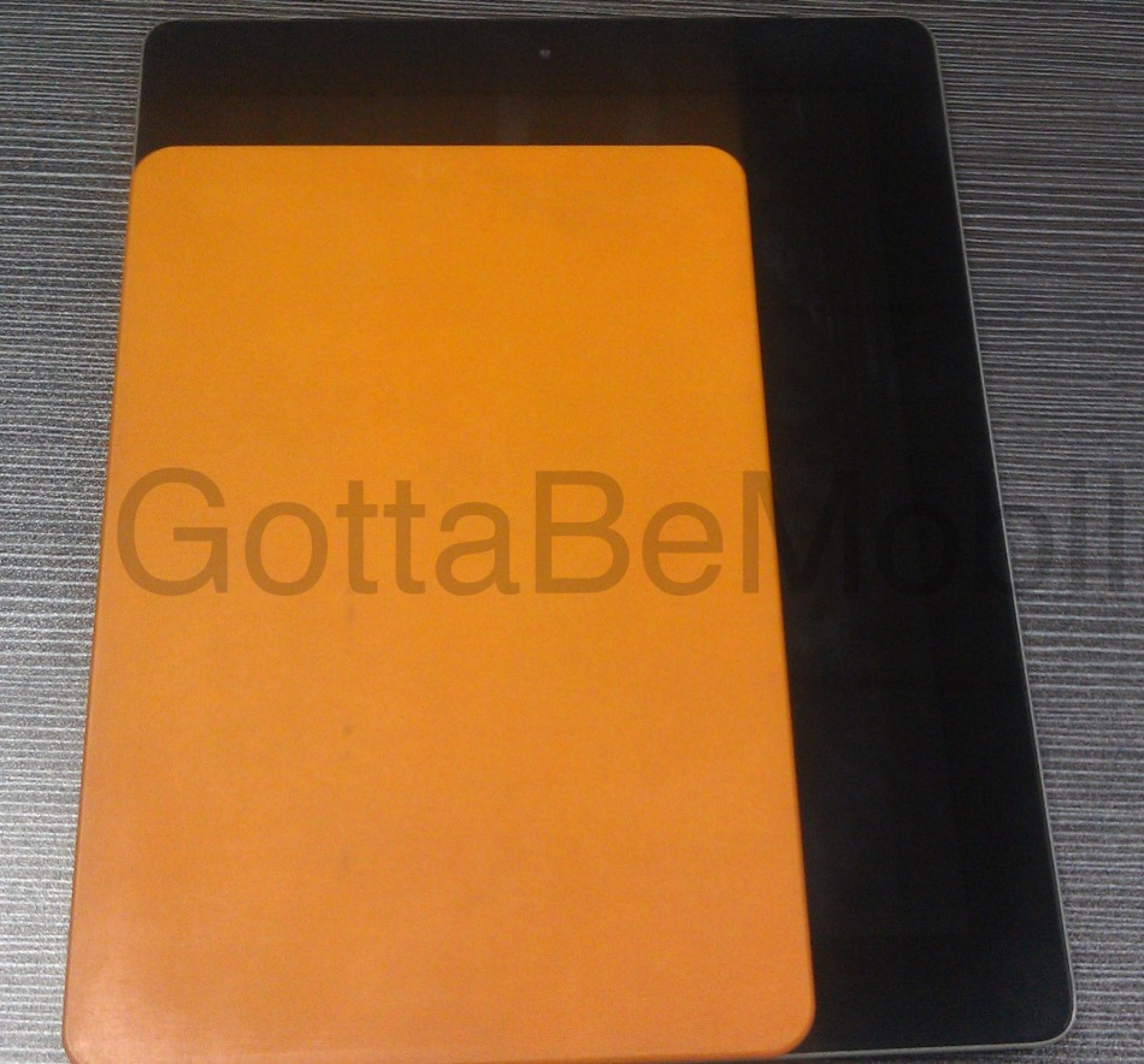Apple iPad Mini Rumors: Schematics And Cases Showcase Likely Features, Specs [PICTURES]
Apple fans are expecting a brand-new mini iPad to be unveiled alongside the iPhone 5 next month, but with the exception of a few molded engineering samples released in the last few months, nobody knows what to expect from Apple's shrunk-down tablet, especially in regards to its appearance.
The iPad Mini has been rumored since early January, back when reports called it the iPad 4, but besides its alleged 7-inch screen, few people have any idea about the tablet's features or its appearance. How wide will the tablet be? How tall? Will it come with front and rear cameras? Will it be thinner or lighter than the new iPad? Many have these questions have been largely unanswered, until now.
On Wednesday, 9 to 5 Mac posted concept images of what it believes the iPad Mini will look like, based on "a number of tips over the last few weeks from sources that we have reason to believe hold knowledge about Apple's plans on the upcoming iPad Mini."
According to the tipsters, Apple has reportedly built its iPad Mini to look like a large iPod Touch with separate volume buttons, a microphone on the back, and smaller bezels along the sides when it stands in portrait mode.
Seth Weintraub of 9 to 5 Mac explains why an iPad Mini with smaller sides may be easier to hold:
"The lack of bezel on the side will not allow you to carry it like you hold a full-size iPad when in portrait mode without triggering some multi-touch on the display," Weintraub wrote. "Perhaps Apple has some software to dull the side touches when in portrait mode. But, really, this is unnecessary. You will need to hold it from the back more like you hold a phone (or one of those 7-inch tablets above). This is not hard, and in fact, it is the de facto way I tend to hold a Nexus 7 even though it has a bezel."
While 9 to 5 Mac was originally unsure of the source's legitimacy, the company discovered a pair of schematics released in mid-July, posted on ThinkiOS, which completely matched up with what the company reported.
According to the schematics, the iPad Mini would be 7.3 mm thick, 134.73mm wide, 200.13mm long, and feature a mini dock connector, redesigned speakers, and add a microphone on the backside. In addition, the iPad Mini will feature a rear camera and a front camera for FaceTime, although the quality of those cameras are still unknown.
ThinkiOS also posted exclusive photos of the iPad Mini cases currently being manufactured by case maker FullHull, which are specifically designed for the new mini tablet. You can check out the photos here.
But in all, everything lines up nicely here. The schematics from mid-July line up perfectly with the new source's information, and the manufactured cases match the specs, to boot.
Just for the sake of historical context, however, let's take a look at what's been previously reported, and see if our new information lines up.
Lining Up With Older Reports
Since early January, rumors of an "iPad Mini" have been circulating the Web, but few knew anything about the size and specifications of the device, other than the fact that its form factor would be slightly bigger than seven inches.
In July, Gotta Be Mobile posted "exclusive" photos of what it believes to be an engineering sample of the "iPad Mini" design, which revealed many possible features of this tiny tablet. Shawn Ingram of Gotta Be Mobile said the engineering sample photos came from a "trusted source inside the Apple supply chain" in Asia.
According to Gotta Be Mobile, the photos suggested the iPad Mini would be wider and a little taller than the Nexus 7, Google's newly introduced 7-inch tablet, and it would even be slightly thinner than Apple's "new" iPad.
"What we've found, using a pixel count, is that the iPad Mini should be around 213.36mm tall and about 143.67mm wide," Ingram said. "This is approximately two-thirds of the size of the new third-generation iPad. The new iPad is 185.67mm wide, 241.3mm tall, and 9.39mm thick."
The sample model did not signify the actual screen size, but most rumors suggest Apple's iPad Mini display will stretch 7.85 inches. One would assume the iPad Mini would boast a Retina Display -- a high-density screen where the individual pixels cannot be discerned with the naked eye -- but word is the iPad Mini will boast an IGZO display, which stands for indium gallium zinc oxide, from Sharp. Sharp's IZGO displays can be fitted for extremely thin hardware devices and can reportedly handle 330 ppi. They are also said to feature better brightness.
The iPad Mini sample model also featured a smaller dock connector on the bottom, which lines up with the rumors -- almost facts, at this point -- that Apple plans to do away with the traditional 30-pin dock connectors for smaller, thinner, 19-pin dock connectors.
We're not entirely sure why Apple has shifted from the traditional dock connectors to these "mini" ports, but one would presume that Apple would not change a significant feature unless there was a good reason for doing it. A mini dock connector must make the device faster, better, or cheaper. Or all of the above.
A smaller dock connector is definitely "better" -- less dock space means more room for other insanely great features (more on those later) -- but it's probably also cheaper to mass produce, and potentially faster, too. Assuming the iPhone decides to makes the 30-pin port obsolete, it would make sense for Apple to build 19-pin ports for all its devices, including the iPad. It's also been rumored that Apple has built an adapter to connect the old 30-pin ports with the new 19-pin dock connectors.
TechCrunch noted that the size of the 19-pin port is similar to the high-speed Thunderbolt I/O: It's possible that Apple's smaller dock solution creates a similarly speedy connection, which would be a nice bonus for manufacturers and consumers that will have to replace their old accessories. Assume there will be an annoying adjustment period where users forget their old accessories like clock radios and stereo systems don't work with their current devices, but producers and consumers will adapt eventually.
On Aug. 3, Apple.pro released some alleged iPad Mini shells courtesy of China's social network Weibo, and while those had most but not all of the features consistent across the iPad Mini rumors and reports, ZooGue released a second set of photos on the same day, which showed features and specs much more consistent with prior reports.
9 to 5 Mac's latest pair of reports, which describe the iPad's alleged specs, matches up perfectly with these previous reports.
iPad Mini: Likely Features
Even though most people could assume a 7-inch "mini iPad" would be able to do most -- if not all -- of the same things a typical iPad can do, there are a few nuances of the tablet's alleged features and specs that may attract -- or repel -- potential customers. Here's what we've heard about the iPad Mini so far:
Display: From a screen perspective, Gotta Be Mobile's photos didn't show any etchings to signify the size of the screen, but most say Apple's iPad Mini display will stretch 7.85 inches.
One would assume the iPad Mini would boast a Retina Display -- a high-density screen where the individual pixels cannot be discerned with the naked eye -- but word on the street is the iPad Mini will also feature an IGZO display -- which stands for indium gallium zinc oxide - from Sharp. Sharp's IZGO displays can be fitted for extremely thin hardware devices and can reportedly handle 330 ppi, which would be incredible since the new iPad can only achieve 264 ppi. IZGO displays are also said to feature better brightness than most LCD screens on the market, so while the display resolution is still unknown, it's possible Apple could pack in plenty of pixels into this 7-inch wonder.
Connectivity: The iPad Mini will definitely be Wi-Fi and Bluetooth 4.0-friendly, but what about cellular connections? The new iPad was the first Apple device to feature LTE, likely done as a test run for the next iPhone, but Apple has every reason to include LTE in the iPad Mini.
Adding LTE gives Apple an excuse to give the iPad Mini more pricing tiers, and higher tiers at that. The new iPad is expensive with just Wi-Fi, costing between $499 and $699. If you add LTE, however, the new iPad costs between $629 and $829, which works out incredibly well for Apple and either Verizon or AT&T. Hopefully, by the time the iPhone 5 and iPad Mini launch, more LTE carriers will sign on so the rates go lower, even if the price of entry stays the same.
Smaller Dock Connector: One of the most rumored and discussed features of the presumed "iPhone 5" has been its dock connector. By now, almost every major news outlet has reported Apple's plans to slim down its traditional dock connector -- the outlet for connecting the iPhone to power sources, devices, utilities and other accessories -- from 30 pins to either 19 pins, or possibly even just nine pins. But it's not just the iPhone: News outlets like Reuters and The Loop say Apple will slim down the dock connectors across all its iOS devices, including the next-generation iPads and iPod Touchs.
The sample model provided by Gotta Be Mobile also includes a smaller dock connector, which lines up with the smaller dock connector rumors, but it makes sense for the iPad: If the next iPhone makes old accessories obsolete, Apple might as well move forward and make all its future mobile devices -- iPads and iPods, included -- compatible with the new dock connector. It's best to have a clean break with the last generation of products.
It's not entirely clear why Apple has chosen to slim down the traditional dock connectors now, but one must presume Apple would not alter a significant feature unless there was a good reason for doing it. A smaller dock connector is definitely "better" -- less dock space means more room for other insanely great features (more on that later) -- but it's probably also cheaper to mass produce, and potentially faster, too.
TechCrunch noted that the size of the alleged 19-pin port is similar to the high-speed Thunderbolt I/O: It's possible that Apple's smaller dock solution creates a similarly speedy connection, which would be a nice bonus for manufacturers and consumers that will have to replace their old accessories. Assume there will be an annoying adjustment period where users forget their old accessories like clock radios and stereo systems don't work with their current devices, but producers and consumers will adapt eventually.
Cameras: On Aug. 3, a rumor swept the Web saying the iPad Mini wouldn't feature a rear camera. The report was only supported by a set of photos posted on the Chinese social network Weibo, which most experts said were "also 99 percent likely to be fake." Trusted Apple source 9 to 5 Mac believes Apple will keep the front and rear cameras in the iPad Mini, although the exact specifications of the cameras are unknown.
If Apple builds the iPad Mini like it built the new iPad with Retina Display, the iPad Mini ought to feature a VGA-quality FaceTime camera on the front and a 5-megapixel iSight camera built with an ƒ/2.4 aperture and Apple's specialized five-element lens. The cameras ought to shoot 5-megapixel stills and record HD video in full 1080p.
Battery: Battery drain is typically an issue with Apple products, but amazingly, most Apple products get between seven and 10 hours of battery life. Nothing is truly known about the iPad Mini's battery, but assuming the tablet has a Retina Display, Apple will likely feature an identical, if not slightly smaller, version of the 42.5-watt-hour rechargeable lithium-polymer battery featured in the new iPad.
Apple always promises 10 hours of battery life on its products, and the iPad Mini will definitely be able to accomplish that bare minimum. What's yet to be determined is how much more battery life, if any, the iPad Mini will have over its larger predecessors.
We might see the same 42.5-watt-hour battery, or maybe a 40-watt-hour battery, or possibly even a 35-watt-hour-battery. Whichever solution helps the iPad Mini accomplish 10 hours of Wi-Fi surfing and 9 hours of Web surfing, Apple will go with. It would be an added bonus if the iPad Mini could squeeze out more battery life and get maybe 11 or 12 hours, and still be cheaper than all previous iPads.
iPad Mini: How About That Price Tag?
The iPad is a proven product. It's thin, light, powerful, intuitive and beautiful, much more so than any other tablet available. The only major issue with the iPad has been the high price of entry.
The competitive landscape isn't very threatening to the iPad now, but that is likely to change soon with the introduction of two cheap, 7-inch tablets from major Apple competitors. Google's Nexus 7 is already a hot product and Microsoft is also getting ready to release its first tablet, the Surface, with a 10.6-inch screen and a few features the iPad lacks. These recent announcements has likely spurred along the development of the iPad Mini, which would become an instant hit with lower-income families and children that want an iPad for themselves. But Apple needs to nail the price on this.
If the iPad Mini costs any more than $250, the company will have failed. The point of the iPad is to make computers accessible, and if the Mini fails to get into consumers' hands -- as unlikely as that is -- Apple risks cannibalizing its own iPad sales and letting newcomers into the space unchecked. Apple needs to hit that sweet $199 price tag. The iPad's success for the next decade depends on it.
What Do You Think?
Which features are on your wish list for the iPad Mini? Do you think the alleged design changes make the iPad look better, or worse? Shoot us an email or drop us a comment in the section below.



© Copyright IBTimes 2024. All rights reserved.




















